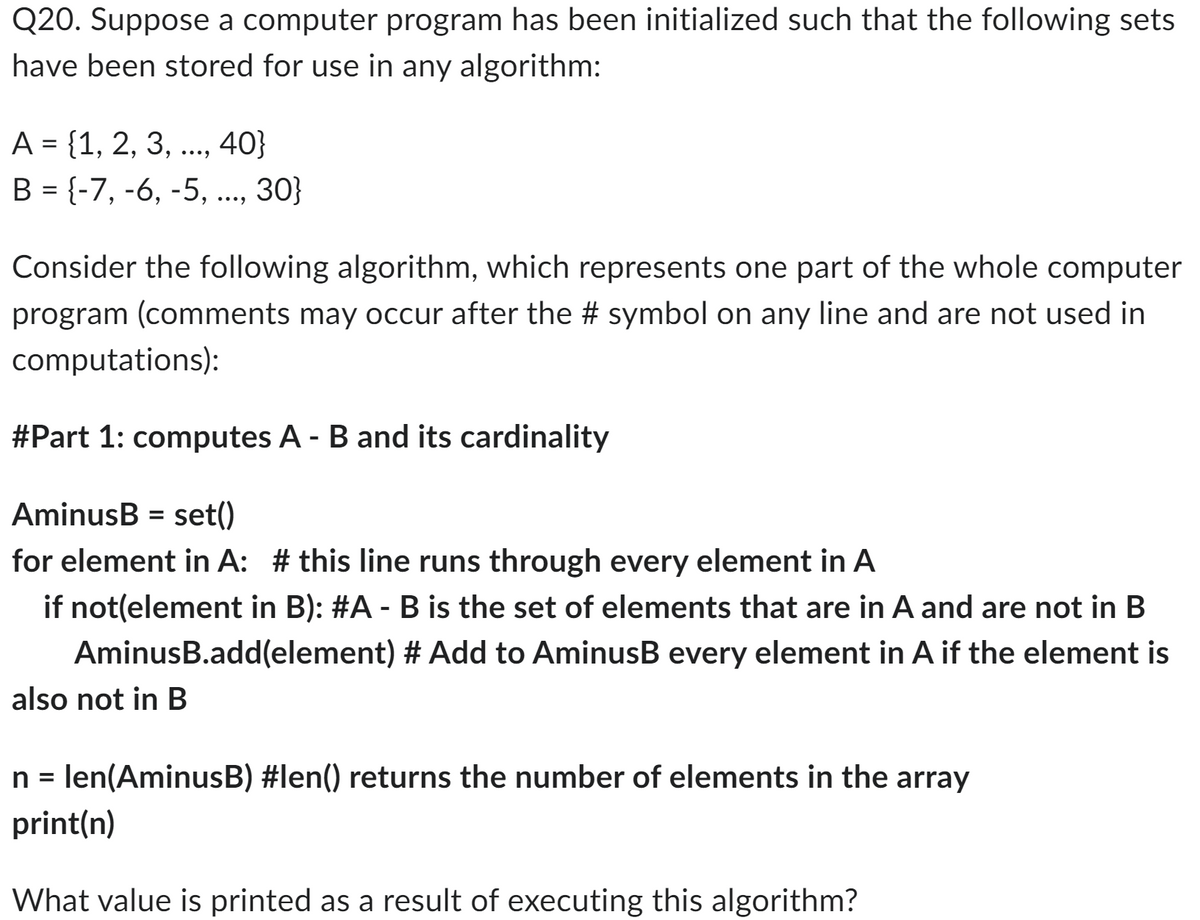Q20. Suppose a computer program has been initialized such that the following sets have been stored for use in any algorithm: A = {1, 2, 3, 40} B = {-7, -6, -5, ..., 30} Consider the following algorithm, which represents one part of the whole computer program (comments may occur after the # symbol on any line and are not used in computations): #Part 1: computes A - B and its cardinality AminusB = set() for element in A: # this line runs through every element in A if not(element in B): #A - B is the set of elements that are in A and are not in B AminusB.add(element) # Add to AminusB every element in A if the element is also not in B n = len(AminusB) #len() returns the number of elements in the array print(n) What value is printed as a result of executing this algorithm?
Q20. Suppose a computer program has been initialized such that the following sets have been stored for use in any algorithm: A = {1, 2, 3, 40} B = {-7, -6, -5, ..., 30} Consider the following algorithm, which represents one part of the whole computer program (comments may occur after the # symbol on any line and are not used in computations): #Part 1: computes A - B and its cardinality AminusB = set() for element in A: # this line runs through every element in A if not(element in B): #A - B is the set of elements that are in A and are not in B AminusB.add(element) # Add to AminusB every element in A if the element is also not in B n = len(AminusB) #len() returns the number of elements in the array print(n) What value is printed as a result of executing this algorithm?
Computer Networking: A Top-Down Approach (7th Edition)
7th Edition
ISBN:9780133594140
Author:James Kurose, Keith Ross
Publisher:James Kurose, Keith Ross
Chapter1: Computer Networks And The Internet
Section: Chapter Questions
Problem R1RQ: What is the difference between a host and an end system? List several different types of end...
Related questions
Question

Transcribed Image Text:Q20. Suppose a computer program has been initialized such that the following sets
have been stored for use in any algorithm:
A = {1, 2, 3, ..., 40}
B = {-7, -6, -5, ..., 30}
Consider the following algorithm, which represents one part of the whole computer
program (comments may occur after the # symbol on any line and are not used in
computations):
#Part 1: computes A - B and its cardinality
AminusB = set()
for element in A: # this line runs through every element in A
if not(element in B): #A - B is the set of elements that are in A and are not in B
AminusB.add(element) # Add to AminusB every element in A if the element is
also not in B
n = len(AminusB) #len() returns the number of elements in the array
print(n)
What value is printed as a result of executing this algorithm?
Expert Solution
This question has been solved!
Explore an expertly crafted, step-by-step solution for a thorough understanding of key concepts.
This is a popular solution!
Trending now
This is a popular solution!
Step by step
Solved in 4 steps with 1 images

Recommended textbooks for you

Computer Networking: A Top-Down Approach (7th Edi…
Computer Engineering
ISBN:
9780133594140
Author:
James Kurose, Keith Ross
Publisher:
PEARSON

Computer Organization and Design MIPS Edition, Fi…
Computer Engineering
ISBN:
9780124077263
Author:
David A. Patterson, John L. Hennessy
Publisher:
Elsevier Science

Network+ Guide to Networks (MindTap Course List)
Computer Engineering
ISBN:
9781337569330
Author:
Jill West, Tamara Dean, Jean Andrews
Publisher:
Cengage Learning

Computer Networking: A Top-Down Approach (7th Edi…
Computer Engineering
ISBN:
9780133594140
Author:
James Kurose, Keith Ross
Publisher:
PEARSON

Computer Organization and Design MIPS Edition, Fi…
Computer Engineering
ISBN:
9780124077263
Author:
David A. Patterson, John L. Hennessy
Publisher:
Elsevier Science

Network+ Guide to Networks (MindTap Course List)
Computer Engineering
ISBN:
9781337569330
Author:
Jill West, Tamara Dean, Jean Andrews
Publisher:
Cengage Learning

Concepts of Database Management
Computer Engineering
ISBN:
9781337093422
Author:
Joy L. Starks, Philip J. Pratt, Mary Z. Last
Publisher:
Cengage Learning

Prelude to Programming
Computer Engineering
ISBN:
9780133750423
Author:
VENIT, Stewart
Publisher:
Pearson Education

Sc Business Data Communications and Networking, T…
Computer Engineering
ISBN:
9781119368830
Author:
FITZGERALD
Publisher:
WILEY